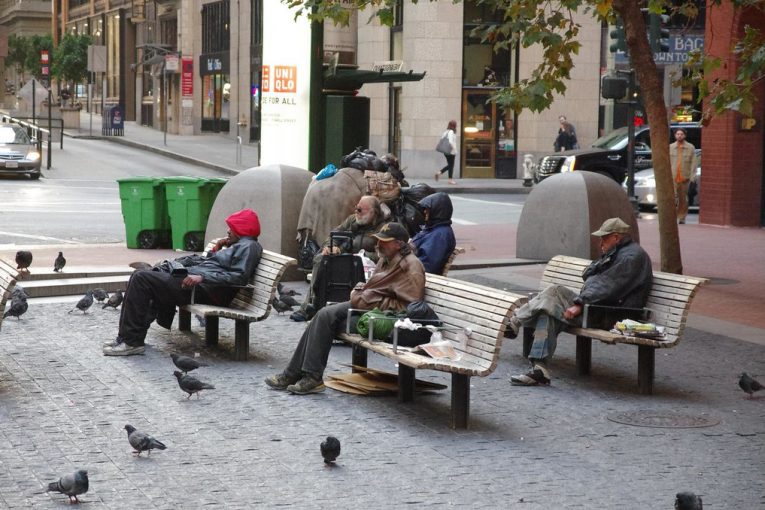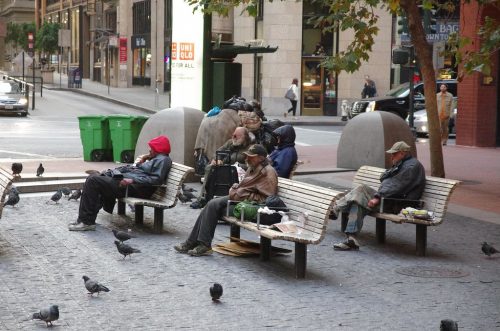

Via Flickr

This work is licensed under a Creative Commons Attribution-NonCommercial-ShareAlike 2.0 Generic License.
By Crescenzo Vellucci
The Vanguard Sacramento Bureau
SAN FRANCISCO, CA – The largest representative study of homelessness in the U.S. in more than a quarter century—since the 1990s—was released Thursday, focusing on California where the study said 30 percent of the homeless live and half of the unsheltered reside—nearly 200,000 are homeless in the state.
The conclusions disclosed by the University of California, San Francisco, Benioff Homelessness and Housing Initiative (BHHI) study found that it’s the “cost of housing” that leaves most of the unhoused out in the streets.
The study charged that “the cost of housing had simply become unsustainable. Participants reported a median monthly household income of $960 in the six months prior to their homelessness, and most believed that either rental subsidies or one-time financial help would have prevented their homelessness.”
“The results of the study confirm that far too many Californians experience homelessness because they cannot afford housing,” said Margot Kushel, MD, Director, UCSF BHHI and principal investigator of CASPEH (CA Statewide Study of People Experiencing Homelessness). “Through thousands of survey responses and hundreds of in-depth interviews, the study’s findings reflect the incalculable personal costs of homelessness. Our policy recommendations aim to inform solutions to the homelessness crisis.”
The study also found that Black and Native Americans are “dramatically overrepresented,” and California’s unhoused population is “aging,” with 47 percent of all adults being 50 years of age and older.
“Contrary to myths of homeless migrants, most (homeless) were Californians: 90 percent of participants lost their last housing in California and 75 percent of participants live in the same county as where they were last housed. Nine out of ten spent time unsheltered since they became homeless. The median length of homelessness was 22 months,” the study noted.
The 96-page report added one in five participants entered homelessness from an institution,” finding, “Of those who hadn’t been in an institution, 60 percent came from situations where they weren’t leaseholders, such as doubling up with family or friends. Participants were disconnected from the job market and services, but almost half were looking for work.”
“As we drive toward addressing the health and housing needs of Californians experiencing homelessness, this study reinforces the importance of comprehensive and integrated supports,” said Dr. Mark Ghaly, Secretary of the California Health and Human Services Agency.
The study also found, “Participants had experienced multiple forms of trauma throughout their life, increasing their vulnerability to homelessness and contributing to their mental health and substance use challenges. Two-thirds reported current mental health symptoms and more than a third experienced physical or sexual violence during this episode of homelessness.
“More than a third had visited an Emergency Department in the prior six months. One in five who used substances reported that they wanted substance use treatment—but couldn’t get it,” the study said.
Based on the CASPEH findings, BHHI offered six recommendations:
“• Increase access to housing affordable to extremely low-income households making less than 30 percent of the Area Median Income: (1) produce more housing affordable to the lowest-income renters; (2) expand rental subsidies (e.g., Housing Choice Vouchers); and (3) ease use of subsidies (e.g., increase housing navigation services, create and enforce anti-discrimination laws).
• Expand targeted homelessness prevention, such as financial supports and legal assistance at, (1) places where people receive other services, including social service agencies, healthcare settings, domestic violence services, and community organizations; and (2) institutional exits (jails, prisons, drug treatment). Expand and strengthen eviction protections.
• Provide robust supports to match the behavioral health needs of the population, by (1) increasing access to low barrier mental health, substance use, and harm reduction services during episodes of homelessness; and (2) staffing permanent supportive housing with evidence-based models, such as pathways to housing, assertive community treatment, and intensive case management.
• Increase household incomes through evidence-based employment supports such as training, support for job search and transportation, and provide outreach to help those experiencing homelessness sign up for eligible benefits.
• Increase outreach and service delivery to people experiencing unsheltered homelessness.
• Embed a racial equity approach in all aspects of homeless system service delivery.”
“Homelessness is devastating to health and well-being. Participants’ experiences were difficult and marked by significant health challenges, high use of drugs and alcohol, frequent victimization, and interactions with the criminal justice system. For the most part, participants were disconnected from the job market and services,” the study emphasized.
The report noted most participants were unsheltered, 21 percent living in vehicles, 57 percent without one, those in shelters were happy with them, but 41 percent said while they wanted shelter, they had no access.
Participants in the study “reported poor health and many health challenges,” with 45 percent in poor or fair health, with nearly a quarter with “mobility limitation,” and 60 percent with chronic disease.
Women of reproductive age are reporting pregnancy was common, with 26 percent claiming they gave birth while homeless and nearly 10 percent being currently pregnant
“Substance use, particularly methamphetamine use, was common; few received treatment. Many participants reported using drugs and alcohol to help them cope with the circumstances of homelessness,” the study found.
And, “nearly one third of participants reported a jail stay during this episode of homelessness. Participants reported that homelessness left them more vulnerable to violence. More than one third of all participants experienced either physical (36 percent) or sexual (10 percent) violence during this episode of homelessness. Cis-women (16 percent) and transgender or non-binary individuals (35%) were more likely to experience sexual violence,” the study added.
Nearly all participants “expressed an interest in obtaining housing, but faced barriers. Nearly nine in 10 participants noted housing costs as a barrier to re-entering permanent housing. Other barriers included lack of necessary documentation, discrimination, prior evictions, poor credit history, challenges associated with physical or behavioral health conditions, and family considerations (such as having enough space for their children),” the study said.
The study also found homeless “believed that financial assistance would help them obtain housing and exit homelessness. Eighty-six percent thought that a monthly subsidy of $300-$500 a month would help them
re-enter housing. Ninety-five percent thought a lump-sum payment of $5,000-$10,000 would help them. Ninety-six percent thought that a Housing Choice Voucher (or similar rental subsidy) would help them re-enter housing.”
“Having experienced homelessness firsthand, I vividly recall the relentless fight for survival, the pervasive shame that haunted me, and my unsuccessful endeavors to overcome homelessness on my own,” said Claudine Sipili, a member of the CASPEH Lived Expertise Board. “The study holds great significance for me because it aims to provide a more comprehensive understanding of homelessness.”
The study surveyed about 3,200 people and held 365 in-depth interviews to determine that Californians experience homelessness chiefly because they cannot afford housing, said Kushel, adding the study found more than 171,000 people are homeless daily in California. 





This is perhaps the most important study yet on the underlying causes of homelessness. It points away from drug use and criminality toward policies that drive up housing prices and the lack of an adequate social safety net. That half are over 50 means that “get a job” will not solve this problem–this population is already discriminated against for hiring. And using the criminal justice system will be equally useless.
Keith Olson ‘s insinuation that illegal immigration is a major contributor of Sacramento’s unhoused population is patently false. Democrats refuse to address this non-issue because this study proves illegal immigration isn’t a major contributor to California’s unhoused population.
If you believe the study.
It’s the most comprehensive study in the last quarter century. It’s typical behavior for conservatives to discount studies when they don’t align with their ideology.
That’s typical and can be said of liberals/progressives too.
When your institution is called ‘Benioff Homeless and Housing Initiative” one might be led to think that their findings are going to support their premise.
How were the study questions framed? Was there research into whether the answers submitted were truthful and correct? Was the study designed to reach a predetermined outcome?
For instance, someone using drugs might say that housing costs are the problem when in fact their fentanyl use is causing their homelessness.
Keith – you ask good questions here.
Have you read the study?
https://homelessness.ucsf.edu/sites/default/files/2023-06/CASPEH_Report_62023.pdf
I would recommend reading chapter two…
Some highlights…
Page 38 captures economic reasons for leaving last housing.
Suggest you read page 43 on issues of mental illness and substance use.
Also page 45 has a table of the self-reported reasons for leaving last housing.
Since you were either unable or unwilling to cite a better study, this is the one Keith that must be referenced.
Keith O
Do you have an alternative study or any other empirical evidence to support your supposition? We know that there personal observational biases that make any general societal conclusions from a small number of direct observations useless. So we need to see your actual evidence that supports the claim that most homeless are in fact undocumented immigrants. Until you can provide that evidence, this study is the best evidence that we have.
And BTW, I present a number of studies that contradict the usual “liberal/progressive” perspective. I’m currently testifying against the current “liberal/progressive” darling of an income graduated fixed charge (IGFC) for electric service. See my article in the San Diego Union-Tribune countering that proposal: https://www.sandiegouniontribune.com/opinion/commentary/story/2023-06-21/opinion-cpuc-sdge-income-based-flat-energy-rates-california-conservation
Richard, I never made the claim that most of our homeless are undocumented immigrants. Please cite where I said that, otherwise quit putting words in my mouth. What I stated is that immigrants crossing the border are only adding to the problem. Every undocumented immigrant that gets housing is just one less unit that could have been used to house our current homeless. Even if we go by the study’s numbers up to 10% of our current homeless could be undocumented immigrants.
What does that have to do with this article? Though I agree with you about the IGFC.
Walter, nothing “must” be referenced. If an only study said that the Earth was flat, must that be referenced?
If it’s the sole study on the table, there is no alternative except for highly biased personal opinions. Your reference to a purely imaginary study that has absolutely nothing to do with the matter at hand is itself absurd.
(I think we found the problem, here.)
Is the problem in your opinion Ron that they don’t make enough money?
Walter: Do you think it’s possible to live anywhere in the country on $960/month?
And if not, would you describe that as a “cost of housing”, or an “income” issue?
Yes
I’m failing to see how that’s a “cost of housing” issue, unless you’re aware of someplace where this type of math works.
And if there is such a place, maybe THAT’s where the homeless should live – rather than choosing some place like San Francisco.
On a broader level, perhaps this is a “capitalistic system” issue. That is, folks are (for the most part) “expected” to be able to support themselves in this system – somewhere.
And $960/month isn’t going to cut it – anywhere.
So first of all, $960 is month is well below poverty levels.
But second of all, the issue is not whether there are other places – the issue is whether there should be housing in general that someone could rent a bed for say $500 or so a month. In a lot of places, you can rent a shared bedroom for that amount. And while the financing would be very tight, you wouldn’t be homeless. Particularly if you had access to the kind of assistance outlined in the report.
Also you seem to not be aware of how Section 8 housing works:
“The rent amount for Section 8 housing in California is determined by a formula that takes into account the family’s income, the size of the family, and the rental market in the area. The formula is designed to ensure that families who receive Section 8 assistance pay no more than 30% of their income towards rent.”
Link: https://affordablehousinghub.org/state-section-8-guides/california-section-8-housing#
Terrific – that’s probably what they should pursue. Might even make more money that way – it wouldn’t be difficult for anyone who isn’t disabled (in some way) to do so.
“Tight” is not the word for it. “Nearly-impossible” comes to mind.
Didn’t read it – did they say where that money is coming from? Also, did they say where the $960 (as reported by respondents) is coming from in the first place?
Your absurd solution as you have previously stated Ron are mass shelters in remote locations where there are no services and other stores such as grocery stores. Also you have previously stated that it’s expensive to move.
As the richest nation on earth we have numerous billionaires that pay very little or zero federal incomes taxes. If they actually were forced to pay income taxes like the rest of us do instead of being freeloaders, that money could be used to fund housing for the nation’s unhoused population.
Free shelter where they’re not bothering others. To make that work, there would also have to be consideration of other needs.
Certainly a “better deal” than those who have to pay to camp in state/national parks where they’re NOT creating a problem for everyone else.
They’re building something like this on the outskirts of Woodland. Don’t know much about it, other than that.
It’s not expensive to move a stolen shopping cart, containing all of one’s belongings.
Good luck with that. Been hearing this type of thing for decades, at this point.
Ron O
Your proposed solution is illegal in that you can not force people to live in a particular location. That’s called imprisonment and illegal under the Fourth Amendment without due process. The Fifth and Sixth Amendments further protect against detention without being charged with a crime.
Where did I say anything about “forcing people to live in a particular location”?
Do you actually read comments, before responding?
Ron, Richard did the same thing to me, put words in my mouth. Look above^^^
So I wonder too if he actually reads the comments before responding?
There are 2 basic ways to get people to move to a shelter, the carrot and stick approaches. Many of the unhoused believe shelters are unsafe because of theft and assaultive behavior among other reasons.